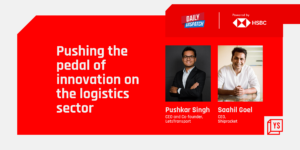In the evolving landscape of financial technology, personalised lending stands out as a significant innovation, aiming to bridge the gap between traditional credit assessment and the diverse financial needs of modern consumers.
By offering tailored loan products to each customer, fintechs can not only improve acceptance rates and increase commission revenues from lenders but also enhance customer satisfaction and generate higher customer loyalty on their app. Higher customer loyalty significantly benefits fintech profitability as they can cross-sell additional products and services to their existing customer base.
Why should fintechs offer personalised loan products?
The benefit most fintechs have over any bank or NBFC (lender) is they can tie up with multiple lenders to offer a broader range of credit products. A particular lender might have stringent risk tolerances or have constraints around lending to particular geographies or certain customer segments, but a fintech can build a portfolio of lending partners that collectively solve these constraints. This allows fintechs to serve a broader customer base appropriately and with the right products that fit their needs.
However, currently, most fintechs don’t have a methodical approach to picking the right product for a customer. As a result, they end up either sending a lead to multiple lenders or sending the full list of lenders to every customer. This leads to lower approval rates from lenders and customers getting multiple phone calls from lenders, ultimately leading to frustration for lenders and customers.
Framework for generating tailored loan offers
To generate the right loan offers for every customer, three things are critical:
Understanding the risk criteria of every lender
It is important to understand the risk thresholds and screening criteria of every lending partner for each product. Some lenders may not be keen on lending to certain types of customers based on income level, bureau score, industry segment, geographical location, and so on. Lenders may not share their entire secret sauce of lending scorecards, but they will certainly share key constraints.
Understanding the risk profile of the customer
To effectively match a customer to a product, it is important to understand the customer’s risk profile. Credit bureau score is the most widely accepted data source, which fintechs can retrieve by a soft pull from the bureaus. Bank statements are another widely accepted data source, particularly for larger ticket-size loans.
However, there is also a wide array of alternative data sources such as GST, financial statements, account aggregators, and device/SMS data, which can be pulled following the guidelines set by RBI and after obtaining the right customer consent.

Mechanism to match the lender and customer risk profiles
In today’s world of lending, fintech systems must be able to make all decisions in real-time. A fintech must have a software system that has a way of effectively matching the customer’s risk characteristics with that of every product from every lender, and suggest the best product match for a customer.
Personalised lending leverages advanced AI algorithms and alt-data to offer bespoke loan products that cater to individual financial situations. Unlike traditional lending models that rely heavily on credit scores and limited financial history, personalised lending requires a broader range of data points, such as bank statements, payment patterns, SMS data, tax returns, and even utility bills.
Standardised frameworks like Account Aggregator (AA) and Open Credit Enablement Network (OCEN) have democratised access to data, enabling fintechs to better assess creditworthiness and provide loan offers that align with customers’ specific needs and repayment capabilities.
Leveraging AI to personalise lending
The fintech industry is increasingly utilising AI-driven platforms to personalise lending and optimise conversion rates. These solutions encompass a range of advanced features that help financial institutions offer tailored loan products to their customers.
AI-driven platforms integrate data from various APIs such as multi-bureau, account aggregator, GST, KYC, payment histories, utility payments, device SMS data, and more. The platform aggregates and analyses this data, automatically generating useful ratios and triangulations that are highly predictive of risk and fraud.
These platforms often feature a user-friendly, drag-and-drop interface that allows fintechs to easily configure lending partners’ risk policies and selection criteria. This intuitive UI can be managed by the credit/risk team without any IT or coding involvement. Each lender’s policies can be stored in separate configurations, ensuring precise alignment with their specific criteria.
Real-time decisioning engine
When a loan application is submitted, the platform pulls additional data as required using built-in API connectors. It then executes all lending partner and product selection criteria as configured on the platform. Based on the probability of approval and loan terms from each lender and product, the system suggests the best lender and product for the customer in real time.
AI-enabled features for continuous improvements
These platforms often include AI modules that test different scenarios and measure their impact on offer take-up rates. This allows fintechs to fine-tune their targeting and product recommendations continuously. The AI/ML algorithms can detect patterns between risk variables and approval outcomes, suggesting changes to risk policies to maximise approval rates.
The measurable outcomes of using such AI-driven solutions include significant increases in response rates (take-up rates) on offers, leading to higher acceptance rates and better financial outcomes for both customers and lenders.
For instance, some leading credit card fintechs in India have seen response rates on pre-approved offers increase from 1.8% to 22%. Other fintechs have reported lender approval rates rising from 22% to 85% over 12 months, thanks to real-time decisioning and personalised product recommendations.
By tailoring loan products, fintechs can achieve higher acceptance rates. Prospective customers are more likely to accept loan offers customised to their financial circumstances and goals, leading to increased conversions and reduced default rates. Additionally, personalised lending fosters a sense of trust and satisfaction among customers, who feel understood and valued by their financial service providers.
(Joydip Gupta is Head of APAC at Scienaptic AI, an AI-powered credit decisioning platform.)
(Disclaimer: The views and opinions expressed in this article are those of the author and do not necessarily reflect the views of YourStory.)


![Read more about the article [Startup Bharat] Coimbatore-based agritech firm aims to generate Rs 7 Cr revenue this year](https://blog.digitalsevaa.com/wp-content/uploads/2022/05/vilfresh-1651493278884-300x150.png)

![Read more about the article [Matrix Moments] Why B2B marketplaces need a separate framework as compared to other models](https://blog.digitalsevaa.com/wp-content/uploads/2021/07/Imageg6e2-1625227664570-300x150.jpg)




![Read more about the article [Jobs Roundup] Work with Bengaluru-based stock investment startup smallcase with these openings](https://blog.digitalsevaa.com/wp-content/uploads/2021/08/Imagezec0-1629887433773-300x150.jpg)
